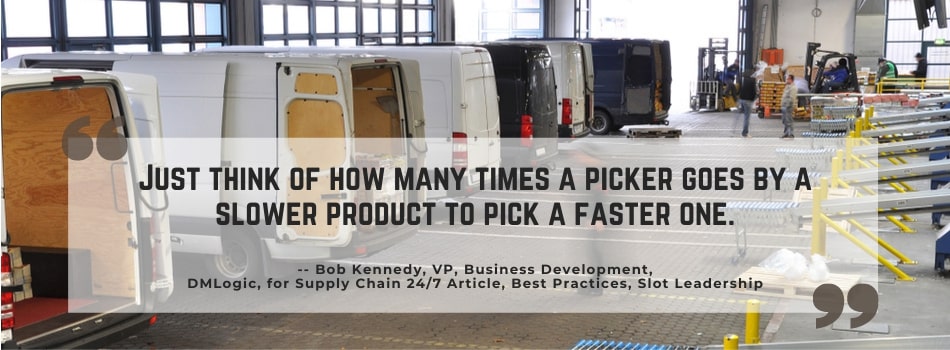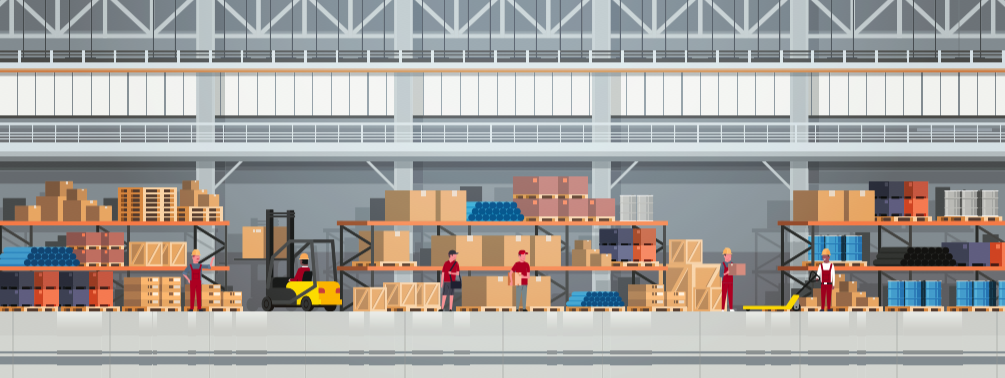Warehouse Slotting Best Practices
Distribution center operations are constantly evolving as innovative technologies arise and client demands continue to climb and change direction. Holding the balance in this dynamic ecosystem is as challenging as ever. Many organizations are staying in lock-step with the latest trends to stay competitive in today’s distribution environment. Automation, a technology that continues to gain momentum and is becoming more readily adopted each year, is one that comes to mind for many looking to improve their operations. These advanced systems (which include robots, conveyors and high-density storage systems) can be a great fit, though the installation times and costs may be high. The necessary expenditures to implement hardware automation may not be in line with an organization’s goals, but the application of automation can be implemented without pricey equipment and lengthy return on investment (ROI).
Warehouse Slotting Best Practices. How do facility managers use the information above to generate a slotting strategy? Item level and storage medium. A slotting strategy should consider whether they pick an item at the pallet level, the case level, or a single piece. Moving a pallet or a case can require a forklift or a cart. WERC's benchmarking and best practices guide is the only comprehensive tool for benchmarking warehouse operations against a proven set of industry standards. It is a powerful, efficient and cost-effective way to assess the caliber of your operations and set a course for improvement. Easy-to-follow instructions for benchmarking your internal. Effective Slotting Effectively Slotting A Warehouse Or Distribution Center Warehouse Slotting: Maximizing Resources Comparison Of Warehouse Slotting Measures What Is Slotting? Slotting A Food Service Warehouse To Increase Profits The Case For Advanced Slotting Systems DC Slotting Best Practices In Racking & Slotting Dynamic Slotting.
Soft Automation in the Warehouse: Capitalizing on Slotting Best Practices through Identification, Definition, and Soft Automation Processes Whitepaper Description Distribution center operations are constantly evolving as innovative technologies arise and client demands continue to climb and change direction. In a simple sense, slotting promotes efficiency. Another major benefit to using slotting in your warehouse is an increase in overall productivity. The slotting process intentionally puts SKUs in an optimal area. This reduces the need for unnecessary guessing of where a product is and establishes the quickest route to get it done.
Soft Automation offers the ability to hone an operation’s best practices in order to create and execute a stream-lined system ensuring standards are met and repeated across the distribution network. With low up-front costs, this standardization of routine processes works to improve operational performance, with prompt ROI. Many complex processes are well suited for soft automation and the addition of advanced mathematics and optimization techniques adds significant value; warehouse slotting falls within this category.
Artificial Intelligence is not a new technology, but widespread adoption and use of AI and machine learning in supply chain is still in its infancy. Nevertheless, there are indications that AI in the warehouse is becoming a reality a lot sooner than most people might have expected.
Preliminary results from a Lucas-commissioned survey of 350 companies in the US and UK found that the majority of the companies are already employing AI in one way or another within their warehouses and distribution/fulfillment centers. A separate survey of retail and CPG supply chain leaders found that AI usage is more prevalent in DCs and warehouses than elsewhere in supply chain – 54% in distribution/fulfillment centers vs. 36% in other supply chain functions. On the surface, that’s a bit of a surprise. But not when you dig a little deeper.
First, a word about the terms artificial intelligence and machine learning, as I am using them here. There are many forms of AI, but for purposes of this article I’m referring to systems that use machine learning approaches to solve specific problems. Machine learning is a process by which learning algorithms are applied to large sets of data to create predictive models. This type of AI can be embedded within robotics (to identify objects), automation (to predict failures), and software systems, including business applications that provide recommendations to managers (suggested product moves) or that initiate actions themselves (such as creating a daily staffing plan).
Now, why is this form of advanced AI emerging so quickly in the DC?
Distribution Centers Are Fertile Grounds For Machine Learning
It turns out that the distribution center is a target rich environment for using AI, with the potential to drive significant operational gains. First, DCs are a controlled environment for collecting and aggregating historical and real-time data – and data is a key to effective AI. By contrast, other supply chain optimization problems often require data that resides in disparate systems, some of which may be controlled by other entities or may not be accessible in real-time.
Furthermore, AI is a natural fit for many of the foundational warehouse management questions that most operators solve today using spreadsheets, inherited best practices, or rules-based decision making. For example, only a minority of DCs today have installed systems for product slotting, workforce planning and other core warehouse functions. The reason is simple: previous expert systems to address these optimization challenges are engineering-heavy and costly to install and maintain.
AI and machine learning-based solutions can eliminate some of those drawbacks. As a result, AI has the potential to make advanced optimization practical for smaller operations, and more flexible and cost-effective for larger facilities.
AI-Based Warehouse Optimization Examples
One of the things that makes machine learning so compelling is that the predictive models are not developed or maintained by teams of engineers, so they are easier to implement. In addition, by their very nature, machine learning systems are designed to adapt to changes in the operating environment. And AI is particularly good at solving complex problems that are difficult to solve with traditional expert systems.

Here are two examples.
AI For Product Slotting
Warehouse Slotting System
Warehouse slotting is both a combinatorial optimization problem (many input factors to consider) and a multiple objective optimization problem (with many goals, sometimes competing). Adding to the challenge, there are typically thousands of products and product locations (slots) involved, and those products and/or locations may change, sometimes frequently.
This is a complex problem with a very large set of possible answers that is very difficult to solve with a general-purpose model. That’s one reason why typical slotting solutions require tremendous amounts of engineering time for each facility. This is the kind of problem that AI is really good at.


AI-based slotting can provide better results and it can lower implementation costs by eliminating much of the engineering work and manual warehouse mapping and data inputs. The AI-based software can learn the spatial characteristics and travel time predictions required for the model based on activity-level data captured in the DC.
AI For Robot and Human Orchestration
Another application of AI is for orchestrating and optimizing warehouse workers and autonomous mobile robots (AMRs). Today, robotic and manual processes can be optimized using various forms of AI, but they are typically optimized independently. Orchestrating and optimizing robot-human workflows is a wholly different challenge.
To take one example, consider an order-picking process using AMRs as a type of picking cart with multiple order totes per AMR, where human pickers are subservient to the AMR’s. As the robotic system directs the robot to a location, a nearby user delivers one or more picks to the robot based on instructions on a tablet mounted to the machine. After completing those picks, the picker finds the next closest robot, and the first robot moves off to its next destination where it meets a second worker. This approach does not require any means to independently direct the human workers, but it also doesn’t optimize their work.
Warehouse Slotting Best Practices
Using AI – and adding a means to direct workers independent of the AMRs (using mobile devices rather than AMR-mounted devices) – the system can orchestrate and optimize for both the robots’ and the pickers’ time. This is accomplished in part using machine learning-based predictions about where the robots and pickers will be located at a given point in time (adjusted in real-time based on actual location data). Separate learning algorithms can organize and sequence the work among people and robots – which orders to group together on each AMR, when to direct a person to a new aisle, etc. This is a more complex problem than independently optimizing the work of people or the AMRs.
AI Removes Barriers To Advanced Warehouse Optimization
As noted above, machine learning requires large amounts of data, but you need the right data for the questions you want to answer. For the DC applications we discussed here, some of the data would not be found in enterprise software systems that capture general transaction data, such as an ERP or WMS.
Instead, machine learning relies on streams of fine-grained data that is often associated with IoT (the Internet of Things) devices, such as mobile robots or the mobile devices used in RF or voice picking applications that collect time-stamped data about every user interaction. In the past, some of this data may have been used for short term purposes (debugging, training, etc.), but it was not usually collected or saved because it had no value beyond those immediate uses. But machine learning can discern patterns and find meaningful information buried in this wealth of IoT data.
Warehouse Slotting Best Practices 2019
Collecting the right data is just one of the challenges to wider AI adoption. In the Lucas survey mentioned earlier, almost 90 percent of respondents said their organizations needed more guidance and direction for implementing AI-based solutions, and 8 in 10 believe there is a general lack of understanding about how AI can be used.
Cost was seen as the biggest perceived impediment to AI adoption among the survey respondents. But the cost for implementing AI-based systems for slotting and other warehouse optimization problems may actually be lower than traditional engineering approaches. In that respect, AI removes barriers to advanced DC optimization.
Warehouse Slotting Rules
Notwithstanding the challenges – both real and perceived – all indications are that warehouses are eager to get started with AI-based solutions. Many DCs are getting started a lot sooner than operators themselves might have thought possible.
Joe Blazick leads the data science team at Lucas Systems, with overall responsibility for the development of advanced data science technologies and AI applications within the Lucas Warehouse Optimization Suite. Prior to Lucas he held research and management positions within the Data Science group at Dick’s Sporting Goods, responsible for developing applications of AI for supply chain. Prior to his civilian career, Joe served for ten years in the U.S. Navy. He holds MS degrees in Finance and Statistics from Rochester Institute of Technology.